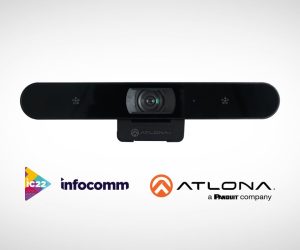
AV Case Study: The Huddle STEM Education Space
North Melbourne football club reinvents STEM education for school kids who most need it. The Game Day Experience Centre won consultant, Mott MacDonald, an AVIA for an innovative and inspiring audiovisual design.
Text:/ Derek Powell
Photos:/ Mott MacDonald & The Ci Group
It’s rare that the award for Best Use of AV in Education should be awarded to a project that’s not located in a school or university but this unique educational experience, The Game Day Experience Centre, certainly hit the mark with the AVIA Judges. The project was initiated by The Huddle, which is the community arm of the North Melbourne Football Club (NMFC).
Since 2010, The Huddle, based at NMFC’s home at Arden Street, North Melbourne, has worked to have a positive impact on locals, both young and old. With a focus on inclusion, it gives the neighbourhood a space for community sport, social activity and education.
When the NMFC decided to upgrade its facilities with the help of HB Arch as architects, it included exploring an upgrade of the Huddle at the same time. Mott MacDonald was engaged in mid-2019 to undertake a small study regarding how the key learning spaces in The Huddle could be enhanced with technology. The result would exceed everybody’s expectations.
YOUNG SCIENTISTS
The experience is aimed at year five and six students who attend the venue in school groups as a day-long educational excursion. Game Day is advertised to teachers as “an immersive AFL-themed Science, Technology, Engineering, and Mathematics excursion with cutting-edge technology”. The AV systems specified by consultants Mott MacDonald and installed by the Ci Group have transformed The Huddle’s existing entrance foyer and oval-shaped Learning space into something very similar to a high-end theme park ride – but one that lasts several hours and has very carefully considered educational outcomes.
Through video screens and a synchronised audio environment, the venue’s atmosphere matches the experience of a major football stadium on game day. Students enter through a corridor flanked by floor-to-ceiling LED screens (from Australian supplier, Aurora) and immersed in a multi-channel ambient soundscape delivered by close proximity speakers. The moving images of crowds outside a real football ground, and sound effects recorded during AFL games at the NMFC’s home ground, Marvel Stadium, mimic the atmosphere before, during and after a game. Just like a theme park ride queueing area, this experience sets the scene and establishes the mood for what is to come in the immersive learning space.


FIELD OF DREAMS
Entering what used to be a simple classroom now feels like walking onto the playing field of a massive stadium. The 1.9mm pixel pitch, close-viewing curved Aurora LED screen wraps around on three sides, following the boundary of an AFL oval marked out on the grass-green floor. The screen shows a continuous panorama of grandstand, broken here and there by scoreboard-like panels displaying player statistics and more. But it is the sound that really brings the stadium illusion to life. To achieve this fully immersive audio experience, The Huddle partnered with Spatial, a 3D audio software suite that promises ‘nearly limitless’ options for designing, creating, and deploying interactive immersive experiences in real-world environments. To implement the audio, integrators, the Ci Group, outfitted the learning space with 21 channels of audio, including six in-ceiling speakers and 15 sidewall speakers placed above and below the LED screens. The audio interactivity is driven by Spatial software which connects with QSC hardware to output triggers to coordinate with the visuals on the seven surrounding screens. The storytelling comes to life through visual and audio cues that drive a completely interactive educational experience.
As they enter, the students meet up with a team of educators and volunteers who use video clips on the massive LED screen as part of a carefully choreographed presentation to introduce the group tasks the students will engage with during the day. A crucial audiovisual element is the control system, which is more like a theatre or theme park than standard AV fare. This was custom built by the Ci Group based on QLab software. As the day unfolds, it enables the educators operating the system to trigger responses via their iPad that are specific to participant answers. It also affords control over theatrical lighting presets that complement the video and audio segments.
“”
The storytelling comes to life through visual and audio cues that drive a completely interactive educational experience


TEAM WORK
As their promotional video explains: “Game Day is designed to simulate a game of AFL. Students work in teams across four quarters to complete a series of Victorian Curriculum-aligned STEM challenges inside the simulation stadium. Their objective for the day will be to unpack and answer the enquiry question: What Does It Take to Win?. To do so, students will work collaboratively and employ their critical and creative thinking skills as they complete a series of challenges that simulate skills like kicking, marking and running.”
There is much more to this program than just a theme-park experience of course. A world-class team from Spatial, MKTG and Beautiful Minds worked to design and produce Game Day, including screenplay, audio, visual, special effects and a pedagogical framework aligned to the Victorian Curriculum.
Using the e5 instructional model, there is a strong alignment to the personal and social curriculum threaded throughout the program. As they progress through the four quarters, powering-up and converting the statistics of the ‘Shinboners’ (an AFL dream team comprising real players from NMFC’s men’s and women’s teams) students will reflect on how their own strengths and attributes have helped them win the game and answer the enquiry question.
The idea is that when they get back on the school excursion bus, they depart better equipped for life than when they arrived that morning. That is quite a lofty ambition, but the club is quite serious about its aims for the North Melbourne community and already has a track record of success. To quote Cameron McLeod, CEO of The Huddle:
“The purpose of The Huddle project was for young school students to experience the power of sport and technology to strengthen education. Throughout 2023, the Game Day session will engage up to 4500 students from 100 schools located in low socio-economic areas across Victoria.
“The football club wanted to address, in a practical way, the rising issues of student disengagement in the classroom and to leverage the power of sport to help young people learn, grow and belong. We believe the technology provided for the purpose has helped us achieve this aim.
“The Game Day program is currently booked out well in advance, and schools are reporting excellent outcomes from their participation.”


GAME ON!
Game Day is one of those projects where the whole becomes so much more than the sum of its parts and where the audiovisual system is really a key part of the educational experience and not just a display exhibiting a screen full of a lecturer’s dot-points.
In awarding the 2023 AVIA Award in the Education category to consultants Mott MacDonald, the Judges praised the community engagement aspects of the Game Day project, noting that its impact has been an experience for year five and six students that re-engages their thinking and creativity towards STEM-based learning.
The AVIA judges particularly applauded the way the AV design and implementation took elements from high-end theatre and concert production and used them to enable a new and immersive approach to teaching. They commented that this is the kind of project that can put audiovisual on a world stage.
EQUIPMENT HIGHLIGHTS
LED Screen: Aurora Signage 1.9mm Pitch Indoor Screen – Curved to Oval shape
Audio Playback System: Spatial Inc USA 21 channels (six in-ceiling; 15 in-wall speakers)
Show Control: Custom by Ci Group using QLab software
TEAM DETAILS:
AV Design/documentation: Mott MacDonald www.mottmac.com
(Charlee Dare, Byron Day)
Architect & Interior Design: HB Arch www.hbarch.com.au
(Gray Barton, Allison Hooper)
Integrator: The Ci Group www.thecigroup.com.au
Content Partners: Spatial www.spatialinc.com
MKTG mktg.com/au
Beautiful Minds beautifulminds.com.au















RESPONSES